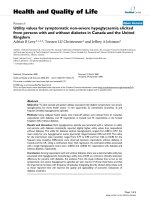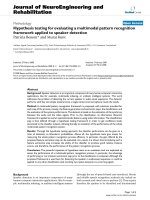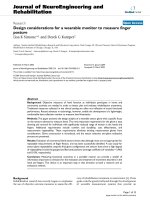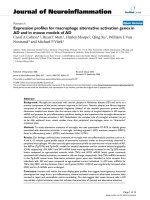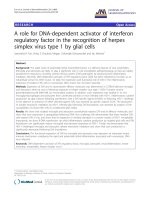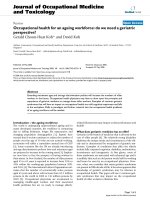Báo cáo hóa học: " SiC formation for solar cell passivation layer using RF magnetron co-sputtering system" pdf
Bạn đang xem bản rút gọn của tài liệu. Xem và tải ngay bản đầy đủ của tài liệu tại đây (486.8 KB, 18 trang )
This Provisional PDF corresponds to the article as it appeared upon acceptance. Fully formatted
PDF and full text (HTML) versions will be made available soon.
SiC formation for solar cell passivation layer using RF magnetron co-sputtering
system
Nanoscale Research Letters 2012, 7:22 doi:10.1186/1556-276X-7-22
Yeun-Ho Joung ()
Hyun Il Kang ()
Jung Hyun Kim ()
Hae-Seok Lee ()
Jaehyung Lee ()
Won Seok Choi ()
ISSN 1556-276X
Article type Nano Express
Submission date 19 September 2011
Acceptance date 5 January 2012
Publication date 5 January 2012
Article URL />This peer-reviewed article was published immediately upon acceptance. It can be downloaded,
printed and distributed freely for any purposes (see copyright notice below).
Articles in Nanoscale Research Letters are listed in PubMed and archived at PubMed Central.
For information about publishing your research in Nanoscale Research Letters go to
/>For information about other SpringerOpen publications go to
Nanoscale Research Letters
© 2012 Joung et al. ; licensee Springer.
This is an open access article distributed under the terms of the Creative Commons Attribution License ( />which permits unrestricted use, distribution, and reproduction in any medium, provided the original work is properly cited.
1
SiC formation for a solar cell passivation layer using an RF magnetron co-
sputtering system
Yeun-Ho Joung
1
, Hyun Il Kang
1
, Jung Hyun Kim
2
, Hae-Seok Lee
3
, Jaehyung Lee
4
,
and Won Seok Choi*
1
1
School of Electrical Engineering, Hanbat National University, Daejeon 305-719,
Republic of Korea
2
Department of Applied Materials Engineering, Hanbat National University, Daejeon
305-719, Republic of Korea
3
Solar Cell R&D Center, Shinsung Solar Energy Co., Ltd., Seongnam 463-420,
Republic of Korea
4
School of Information and Computer Engineering, Sungkyunkwan University, Suwon
440-746, Republic of Korea
*Corresponding author:
Email addresses:
Y-HJ:
HIK:
JHK:
H-SL:
JL:
WSC:
Abstract
In this paper, we describe a method of amorphous silicon carbide film formation for
a solar cell passivation layer. The film was deposited on p-type silicon (100) and glass
substrates by an RF magnetron co-sputtering system using a Si target and a C target at a
room-temperature condition. Several different SiC [Si
1-x
C
x
] film compositions were
achieved by controlling the Si target power with a fixed C target power at 150 W. Then,
structural, optical, and electrical properties of the Si
1-x
C
x
films were studied. The
2
structural properties were investigated by transmission electron microscopy and
secondary ion mass spectrometry. The optical properties were achieved by UV-visible
spectroscopy and ellipsometry. The performance of Si
1-x
C
x
passivation was explored by
carrier lifetime measurement.
Keywords: a-Si
1-x
C
x
; passivation layer; RF magnetron co-sputtering system; carrier
lifetime; solar cell.
Introduction
Semiconductor technology or microelectronics including solar cells has been adopted
to form micro- or nano-sized state-of-the-art structures which can reduce system size,
improve its performance, achieve lower system cost, and so on [1-3]. Generally, a
semiconductor structure or system is manufactured by a combination of additive (film
deposition) and subtractive (etching) processes. These days, many research have tried to
utilize the microelectronic technology (especially in the deposition of thin film layers)
to get more efficient and cost-effective solar cells [4, 5].
Amorphous silicon-based thin film layers (SiO
2
, SiN, a-SiC:H, and so on) for
antireflection coatings, diffusion barriers, passivation layers, and silicon bulk materials
have been broadly researched in the solar cell industry. Among the film layers, SiO
2
and
SiN passivation layers have highly attracted to fabricate high-efficiency silicon solar
cells. However, they have negative demerits such as the need for a high-temperature
process, difficulty in the photolithography process, and poor thermal stability [6-8].
Hydrogenated amorphous silicon carbide [a-SiC:H] has been studied for solar cell
passivation layers due to its wide bandgap, excellent coefficient of thermal expansion
that matches with silicon wafers, relatively good thermal and mechanical stabilities,
superior cost-of-ownership compared to other materials, and so on. The formation or
deposition of the a-SiC:H film has mainly been done by plasma-enhanced chemical
vapor deposition [9, 10]. However, the thermal stability of the hydrogen-containing film
is degraded during a post-high-temperature firing process. To avoid the hydrogen
molecule's void generation, the authors have proposed an a-SiC deposition method by
radio frequency [RF] sputtering which was performed by a single silicon-carbide
composite target in an argon environment [10]. In this paper, we introduce a deposition
method of amorphous silicon carbide [a-Si
1-x
C
x
] which was done by RF magnetron co-
sputtering. The method can utilize multiple targets (in this paper, Si and C)
simultaneously in order to deposit complex compositional coatings. The compositional
ratio can be controlled by the differences in sputtering yield, the relative ability of the
3
materials to stick to the substrate, the deposition temperature, and the relevant percent
of sputtered elements to reach the substrate without being scattered from the plasma. In
this paper, we investigate several properties of the compositional films by controlling
the Si target's RF power. Film thickness was measured using a field-emission scanning
electron microscope [FE-SEM]. Reflective index of the film was obtained using an
ellipsometer, and carrier lifetime of the film on the doped p-type silicon wafer was
obtained by a silicon wafer lifetime tester.
Experimental details
The a-Si
1-x
C
x
passivation layer was deposited on 2 × 7-cm glass substrates and 4-inch
p-type silicon (100) wafers using an RF magnetron co-sputtering system. Figure 1
shows the schematic diagram of our RF magnetron co-sputtering system. Before the RF
plasma process, the substrates were cleaned in trichloroethylene, acetone, methanol, and
distilled water for 10 min. For the silicon wafers, an acid treatment was added for 45 s.
Pure (99.9%), 4-inch Si and C targets were installed to achieve a high-quality a-Si
1-x
C
x
passivation layer. The sputtering chamber was vacuumed up to the base pressure of 1 ×
10
−5
Torr using a turbomolecular pump. A highly pure (99.9999%) argon environment
was established for the deposition with a flow of 40 sccm. Then, the Si and C targets
were pre-sputtered to clean the target surface and the chamber for 10 min. The target-to-
substrate distance and the substrate rotation speed were fixed for all depositions as 6 cm
and 1,700 rph, respectively. In this work, to check the effect of the Si-to-C ratio on the
a-Si
1-x
C
x
passivation layers, the RF power of the C target was fixed at 150 W, and
several different RF powers (100, 150, 175, and 200 W) of the Si target were applied to.
However, the thicknesses of all a-Si
1-x
C
x
passivation layers were kept constant at 100
nm by controlling the deposition rate. The deposition rates with the different RF powers
of the Si target were summarized in Figure 2, and the detailed experimental parameters
were summarized in Table 1.
The deposited a-Si
1-x
C
x
passivation layer's thickness and crystal structure were
measured using an FE-SEM (S-4800, Hitachi, Tokyo, Japan) and a transmission
electron microscope [TEM] (JEM-2100F, JEOL, Seoul, South Korea), respectively.
Optical properties of the transmittance and bandgap were measured by UV-visible
spectroscopy (S-3100, Scinco, Seoul, South Korea), the refractive indexes were
obtained using an ellipsometer (M2000D, Woollam, Uiwang-si, South Korea), and the
electrical performance of the a-Si
1-x
C
x
passivation layer was analyzed by carrier lifetime
measurement (WCT-120, Sinton Consulting Inc., Boulder, CO, USA).
4
Results and discussion
As mentioned in the ‘Experimental details’ section, the film thickness was fixed at
100 nm. The thickness was measured with three different apparatuses, such as FE-SEM,
TEM, and secondary ion mass spectrometer [SIMS]. Figure 3 shows cross-sectional
bright field TEM images with a variation on the RF power of the silicon target. As the
RF power of the Si target goes higher, the color of the Si1-xCx film gets darker due to
the Si-rich compositional ratio of the film. It may indicate that the compositional ratio
of the SiC is changed by the RF target power of the element.
SIMS is widely used in the profile distribution of compositional elements along the
deposited film depth by detecting the ionized element's mass. Figure 4 shows the depth
profiles of Si and C along the deposited film. By increasing the RF power of the Si
target, the mass intensity of the silicon particle gets higher than that of carbon. When we
applied the same RF power on both targets, the compositional ratio of the elements
seems to be 50:50 in mass intensity. When it goes deeper near the p-type silicon surface
region, the carbon intensity is decreased abruptly. The falling point of the carbon
intensity indicated the thickness of the a-Si1-xCx film with a sharp boundary between
the film and the substrate.
Figure 5a shows the refractive index spectra of the a-Si
1-x
C
x
passivation films
measured using an ellipsometer as a function of the Si target's RF power. The refractive
indexes in the wavelength range of 400 to 1,000 nm are increased when a higher RF
power of the Si target is applied. At a 200-W RF power of the Si target, the refractive
index value is highest all over the wavelength range. Generally, the refractive index of
Si is higher than that of C (Si ≈ 3.49, C ≈ 2.41 at 630 nm). Therefore, when the RF
power of the Si target goes up, more Si ions are deposited on the film. This Si-rich film
makes a higher refractive layer. Figure 5b describes one point of refractive index at 630
nm which is a standard wavelength for optical properties in the visible wavelength
regime and is a red-light wavelength. We obtained a refractive index of 2.7 at the 100-W
RF power of the Si target. Then, by increasing the RF power of the Si target, the
refractive index goes up, and at the 200-W RF power, we achieved the highest refractive
index of 3.7. This result has a very similar trend with our previous experiment which
was done with a single SiC composite target [5]. The previous result has a very narrow
refractive index variation (3.2 to 3.4) with the change of a large RF power range (150 to
300 W), but co-sputtering method shows a relatively large refractive index variation
(2.7 to 3.7). That is, we have more controllability of the refractive index selection for
the passivation layer.
The optical bandgaps were calculated from optical absorption measurement of the
5
thin films which were deposited on the glass substrates. The optical absorptions were
obtained from the intensity of the light measured by UV-visible spectroscopy [11].
Then, the optical bandgaps of the films were determined by the Tauc plot method which
was performed by extrapolating the linear part of the absorption vs. photon energy
(αhν)
1/2
curves [12, 13]. Figure 6 shows the optical bandgap as a function of the RF
power of the Si target. The absorption bandgaps are decreased from 1.4 to 0.9 eV as the
RF power of the Si target is increasing. In general, the optical bandgap of carbon (≈5.5
eV at room temperature [RT]) has a much higher value than that of Si (≈1.11 eV at RT).
When the Si target power is increasing, the film is changed to a Si-abundant layer.
Therefore, it is reasonable that the higher RF power of the Si target brings a thin film
with a lower optical bandgap.
Figure 7 shows the carrier lifetime of the a-SiC passivation layer measured by a
silicon wafer lifetime tester with the function of Si target power. The carrier lifetime of
the passivation layer deposited with a 100-W Si target power was 8.9 µs. Samnanta et
al. reported that impurity in the semiconductor can degrade the lifetime by the creation
of an electrical defect center or crystal imperfection [14]. Therefore, a carbon-rich thin
layer can have more microdefects than a Si-rich film. In our study, the carrier lifetime
was gradually decreased from 8.9 to 6.0 as the RF power of the Si target is increased
from 100 to 200 W.
Conclusions
We demonstrate a formation method of an a-Si
1-x
C
x
passivation layer for Si solar
cells. The method was performed by RF magnetron co-sputtering with a Si target and a
C target. The a-Si
1-x
C
x
passivation layer was deposited on p-type silicon (100) and glass
substrates with the reaction of argon (Ar) gas. In this work, we have checked the effect
of the Si-to-C ratio on the a-Si
1-x
C
x
passivation layers with variation on the RF powers
of the Si target (100, 150, 175, and 200 W) and with fixation on the RF power of the C
target (150 W). However, the thicknesses of all a-Si
1-x
C
x
passivation layers were kept
constant at 100 nm. The SIMS profile showed that the film composition is changed with
a variation on the RF power of the Si target. The refractive index analysis indicated that
a Si-rich thin film has higher refractive index. We could obtain the highest refractive
index of 3.7 with a 200-W RF power of the Si target. The optical bandgap analysis
showed that the bandgap of the Tauc plot was observed to decrease gradually from 1.4
to 0.9 eV. The carrier lifetime analysis showed that the carrier lifetime of the a-Si
1-x
C
x
passivation layer was observed to decrease gradually from 8.9 to 6.0 µs as the carbon
ratio in the film is decreased by changing the Si target power. Therefore, we could
6
conclude that the RF magnetron co-sputtering method for SiC can deposit a thin film
passivation layer for solar cells with various compositional ratios of Si and C.
Competing interests
The authors declare that they have no competing interests.
Authors' contributions
Y-HJ and WSC carried out the molecular genetic studies, participated in the sequence
alignment, and drafted the manuscript. HIK and JHK carried out the immunoassay
sample preparation. H-SL and JL participated in the sequence alignment. All authors
read and approved the final manuscript.
Acknowledgments
This work was supported by the New IT Project for global competitiveness
strengthening of the advanced mobile devices and equipments of the Chungcheong
Leading Industry Office of the Korean Ministry of Knowledge Economy.
References
1. Song D, Cho EC, Conibeer G, Flynn C, Huang Y, Green MA: Structural, electrical
and photovoltaic characterization of Si nanocrystals embedded SiC matrix and
Si nanocrystals/c-Si heterojunction devices. Sol Energ Mat Sol C 2008, 92:474-
481.
2. Yunaz IA, Hashizume K, Miyajima S, Yamada A, Konagai M: Wide-gap a-SiC:H
solar cells with graded absorption layer for triple cell applications. In
Conference Record of the 33rd IEEE PVSC 2008: May 11-16 2008; San Diego, CA.
IEEE; 2008:1-5.
3. Schultz O, Rentsch J, Grohe A, Glunz S, Willeke G: Dielectric rear surface
passivation for industrial multicrystalline silicon solar cells. In Conference
Record of the 2006 IEEE 4th World Conference on Photovoltaic Energy
Conversion: May 7-12 2006; Waikoloa, HI. IEEE; 2006:885-889.
4. Seo JK, Joung YH, Park Y, Choi WS: Substrate temperature effect on the SiC
passivation layer synthesized by an RF magnetron sputtering method. Thin
Solid Films 2011, 519:6654-6657.
5. Seo JK, Ko KH, Choi WS, Park M, Lee JH, Yi JS: The effect of deposition RF
power on the SiC passivation layer synthesized by an RF magnetron sputtering
method. J Cryst Growth 2011, 326:183-185.
7
6. Kobayashi H, Imamura K, Kim WB, Im SS, Asuha: Nitric acid oxidation of Si
(NAOS) method for low temperature fabrication of SiO
2
/Si and SiO
2
/SiC
structures. Appl Surf Sci 2010, 256:5744-5756.
7. Araki K, Yamaguchi M: An Si concentrator cell by single photolithography
process. Sol Energ Mat Sol C 2001, 65:437-443.
8. Lucovsky G: Atomic structure and thermal stability of silicon suboxides in bulk
thin films and in transition regions at Si–SiO
2
interfaces. J Non Cryst Solids
1998, 227:1-14.
9. Yu Z, Pereyra I, Carreno MNP: Wide optical band gap window layers for solar
cells. Sol Energ Mat Sol C 2001, 66:155-162.
10. Saleh R, Munisa L, Beyer W: The diffusion of hydrogen and inert gas in
sputtered a-SiC:H alloys: microstructure study. Sol Energ Mat Sol C 2006,
90:3449-3455.
11. Davis EA, Mott NF: Conduction in non-crystalline systems. V. Conductivity,
optical absorption and photoconductivity in amorphous semiconductors. Philos
Mag 1970, 22:903-922.
12. Pierson JF, Thobor-Keck A, Billard A: Cuprite, paramelaconite and tenorite
films deposited by reactive magnetron sputtering. Appl Surf Sci 2003, 210:359-
367.
13. Ray SC: Preparation of copper oxide thin film by the sol–gel-like dip technique
and study of their structural and optical properties. Sol Energ Mat Sol C 2001,
68:307-312.
14. Samnanta S, Maikap S, Chatterjee S, Maiti C: Minority carrier lifetime and
diffusion length in Si
1−x−y
Ge
x
C
y
heterolayers. Solid-State Electonic 2003, 47:893-
897.
Figure 1. A schematic diagram of the RF magnetron co-sputtering system.
Figure 2. Deposition rate of a-Si
1-x
C
x
passivation layer as a function of the Si
target's RF power.
Figure 3. TEM images. At (a) 100-, (b) 150-, and (c) 200-W RF powers of the Si
target.
Figure 4. Depth profiles as functions of the Si target's RF powers. (a) 100, (b) 150,
and (c) 200 W.
8
Figure 5. Refractive index of a-Si
1-x
C
x
passivation layer as a function of the Si
target's RF power. (a) Refractive index, n. (b) One point of refractive index, n (630
nm).
Figure 6. Optical bandgap as a function of the Si target's RF power.
Figure 7. Carrier lifetime of a-Si
1-x
C
x
passivation layer as a function of the Si
target's RF power.
Table 1. Deposition conditions of the a-Si
1-x
C
x
passivation layer
Deposition parameters Conditions
Substrate Glass and Si substrates
Base pressure 0.01 mTorr
Working pressure 3 mTorr
RF power C target, 150 W
Si target, 100; 150; 175; and 200 W
Target-to-substrate distance 6 cm
Rotation speed 1,700 rph
Target 4-inch Si and C
Sputtering gas Ar, 40 sccm
Substrate temperature RT
RF, radio frequency; RT, room temperature.
Figure 1
100 125 150 175 200
3
4
5
6
7
8
9
Growth rate (nm/min)
RF power of Si target (W)
B
C
Figure 2
Si
SiC
100W
SiC
Si
150W
SiC
Si
200W
Figure 3
0 50 100 150 200 250 300
Depth, nm
1e1
1e2
1e3
1e4
1e5
1e6
Intens, c/s
S
C
0 50 100 150 200 250 300
Depth, nm
1e1
1e2
1e3
1e4
1e5
1e6
Intens, c/s
S
C
150W
0 50 100 150 200 250 300
Depth, nm
1e1
1e2
1e3
1e4
1e5
1e6
Intens, c/s
S
C
100W
200W
Figure 4
400 500 600 700 800 900 1000
2.4
2.6
2.8
3.0
3.2
3.4
3.6
3.8
4.0
100 W
150 W
175 W
200 W
Refractive index, n
Wavelength (nm)
100 125 150 175 200
2.4
2.6
2.8
3.0
3.2
3.4
3.6
3.8
Refractive index, n
RF power of Si target (W)
630 nm
"
*c+"
*d+"
Figure 5
Figure 6
Figure 7

